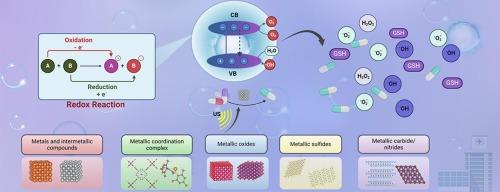声催化生物材料
IF 20.3
1区 化学
Q1 CHEMISTRY, INORGANIC & NUCLEAR
引用次数: 0
摘要
超声波(US)触发的催化剂可以在复杂的生物条件下引发各种氧化还原催化反应,为多种疾病治疗带来了重要的应用前景,这被统称为 "声催疗法"(SCT)。通常情况下,一系列源于声催化生物材料的有机或无机声敏化剂在 US 的刺激下产生大量活性自由基,包括超氧离子(-O2-)、羟自由基(-OH)和单线态氧(1O2),有望用于组织修复、杀菌和肿瘤治疗。为促进声催化生物材料在 SCT 领域的临床转化,本综述全面总结和概述了声催化生物材料的基础机理、合成、改性和功能化,并重点介绍了其在抗肿瘤治疗、组织再生和抗菌治疗等方面的生物医学应用。特别是讨论了声催化生物材料在声催化医学中面临的挑战和未来展望。随着对声催化机制的深入了解以及方法和技术的发展,声催化生物材料支持/增强 SCT 的进一步临床转化有望最终造福人类健康。本文章由计算机程序翻译,如有差异,请以英文原文为准。

Sonocatalytic biomaterials
Ultrasound (US)-triggered catalysts can initiate various redox catalytic reactions in complex living conditions, presenting significant application prospects for versatile disease treatments, which is described as a collective term “sonocatalytic therapy” (SCT). Typically, a series of organic or inorganic sonosensitizers originating from sonocatalytic biomaterials are stimulated by US to generate abundant reactive radicals, including superoxide ions (·O2−), hydroxyl radicals (·OH), and singlet oxygen (1O2), which hold promise for tissue repair, sterilization, and tumor therapy. To promote the clinical transformation of sonocatalytic biomaterials in SCT, this review comprehensively summarizes and outlines the underlying sonocatalytic mechanism, synthesis, modification, and functionalization of sonocatalytic biomaterials, and focuses on their versatible biomedical applications in antitumor therapy, tissue regeneration, and antibacterial treatment. Especially, the facing challenges and future outlook of sonocatalytic biomaterials in sonocatalytic medicine are discussed. With the insight into the sonocatalytic mechanism and the development of methodological and technologies, further clinical transformation of sonocatalytic biomaterials-enabled/augmented SCT is expected to ultimately benefit the human health.
求助全文
通过发布文献求助,成功后即可免费获取论文全文。
去求助
来源期刊

Coordination Chemistry Reviews
化学-无机化学与核化学
CiteScore
34.30
自引率
5.30%
发文量
457
审稿时长
54 days
期刊介绍:
Coordination Chemistry Reviews offers rapid publication of review articles on current and significant topics in coordination chemistry, encompassing organometallic, supramolecular, theoretical, and bioinorganic chemistry. It also covers catalysis, materials chemistry, and metal-organic frameworks from a coordination chemistry perspective. Reviews summarize recent developments or discuss specific techniques, welcoming contributions from both established and emerging researchers.
The journal releases special issues on timely subjects, including those featuring contributions from specific regions or conferences. Occasional full-length book articles are also featured. Additionally, special volumes cover annual reviews of main group chemistry, transition metal group chemistry, and organometallic chemistry. These comprehensive reviews are vital resources for those engaged in coordination chemistry, further establishing Coordination Chemistry Reviews as a hub for insightful surveys in inorganic and physical inorganic chemistry.
 求助内容:
求助内容: 应助结果提醒方式:
应助结果提醒方式:


